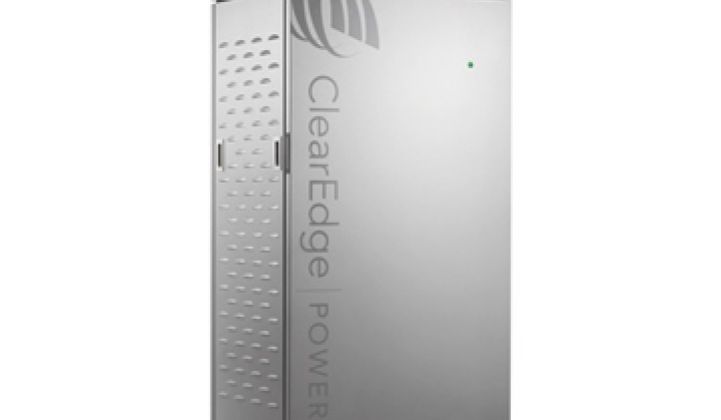ClearEdge Power, a fuel cell startup that closed a $73.5 million VC round in 2011, just scored one of the largest fuel cell orders in the 150-year history of fuel cells.
The firm builds proton exchange membrane (PEM) fuel cells that produce electricity and heat from natural gas. It just inked a 50-megawatt supply agreement with Austria's Güssing Renewable Energy (GRE). The first phase is the delivery of 8.5 megawatts of fuel cells over the next three years. That's about 1,700 5-kilowatt modules. Phase two is 20 megawatts by 2020 in what ClearEdge says is a $500 million agreement.
GRE is a provider and developer of community-centric carbon-neutral energy, as well as an investor in ClearEdge.
The ClearEdge fuel cells will initially be powered by plumbed utility natural gas but eventually will be powered by gassified wood chips and biomass in some of the deployments. ClearEdge President and CEO, Russell Ford, said that what Güssing Renewable Energy is trying to accomplish is the convergence of renewables, fuel cells, and biogas along with energy storage.
While we're on the subject of big fuel cell orders:
- FuelCell Energy has a technology transfer agreement with Korea's POSCO for its molten carbonate fuel cells, with orders that include a 5.6-megawatt fuel cell power plant in Busan city, as well as an MOU for a 60-megawatt fuel cell power plant in Hwaseong, according to the POSCO website.
- Bloom Energy has a 7.5-megawatt order with AT&T and a 30-megawatt order with Delaware's utility.
- UTC's phosphoric acid fuel cells have almost 10 million kilowatt-hours of field experience, according to the firm.
- Other players in the small stationary fuel cell space include Ceramic Fuel Cells, Panasonic, and Ceres Power.
Although fuel cells have had a reputation for reliability issues, Ford noted in a previous interview that improvements in materials used in fuel cells such as membranes and catalysts have progressed with the same speed as semiconductors. Membranes in the fuel cell stack are sixth-generation devices and catalysts can last for six to seven years. He also stressed that control systems, sensor arrays and better predictive monitoring contribute to improved fuel cell reliability.
The CleanEdge fuel cell can also run on propane or methane and can export excess heat for hot water, forced hot air, or hot-water cleaning.
The CEO noted that "fuel cells do things that batteries can't do -- fuel cells can run continuously, 24/7, for years." The CEO also noted that the most of the other fuel cell vendors operate at high temperatures compared to the 165-degree-Celsius, PEM-based ClearEdge unit. The high operating temperatures of competitors' technologies necessitate exotic and expensive components, plastics, and resins, according to Ford.
ClearEdge might be able to outperform batteries and other fuel cells, but the problem is that the real competition is the grid and diesel gen-sets. And few if any fuel cells have proven that they can go head-to-head with those incumbent technologies on a per-kilowatt-hour basis. Even after incentives, the fuel cell's initial cost is expensive compared to the grid or to a diesel gen-set.
Fuel cells can be distributed and do have less emissions. But for fuel cells dependent on the natural gas grid, there's the downside of volatile prices and the sometimes less-than-green processes used to extract natural gas.
The integrated biomass system that ClearEdge and GRE are working on might address some of those downsides.
The Hofbauer Reactor, used in a deployment by Güssing Renewable Energy to turn organic mass into biogas that powers ClearEdge's fuel cells.
_526_350_80.jpg)



